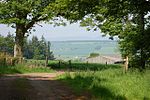Forteviot Bronze Age tomb
Forteviot Bronze Age tomb is a Bronze Age burial chamber discovered in 2009 at Forteviot near Perth, Scotland. The Bronze Age tomb is one of a number of archaeological digs at the site that Co-directors of the excavation, Dr. Gordon Noble of the University of Aberdeen, and professor Stephen Driscoll and Dr Kenneth Brophy, both of the University of Glasgow, are currently conducting. The excavation at Forteviot is part of a long-term collaborative study by the Strathearn Environs and Royal Forteviot (SERF) project – funded by Historic Scotland and the Perth and Kinross Heritage Trust – to study the archaeology of the former Pictish royal centre in the Strathearn region of what later became Central Scotland.
Excerpt from the Wikipedia article Forteviot Bronze Age tomb (License: CC BY-SA 3.0, Authors).Forteviot Bronze Age tomb
B935,
Geographical coordinates (GPS) Address Nearby Places Show on map
Geographical coordinates (GPS)
| Latitude | Longitude |
|---|---|
| N 56.340394444444 ° | E -3.5302888888889 ° |
Address
B935
PH2 9BT
Scotland, United Kingdom
Open on Google Maps







